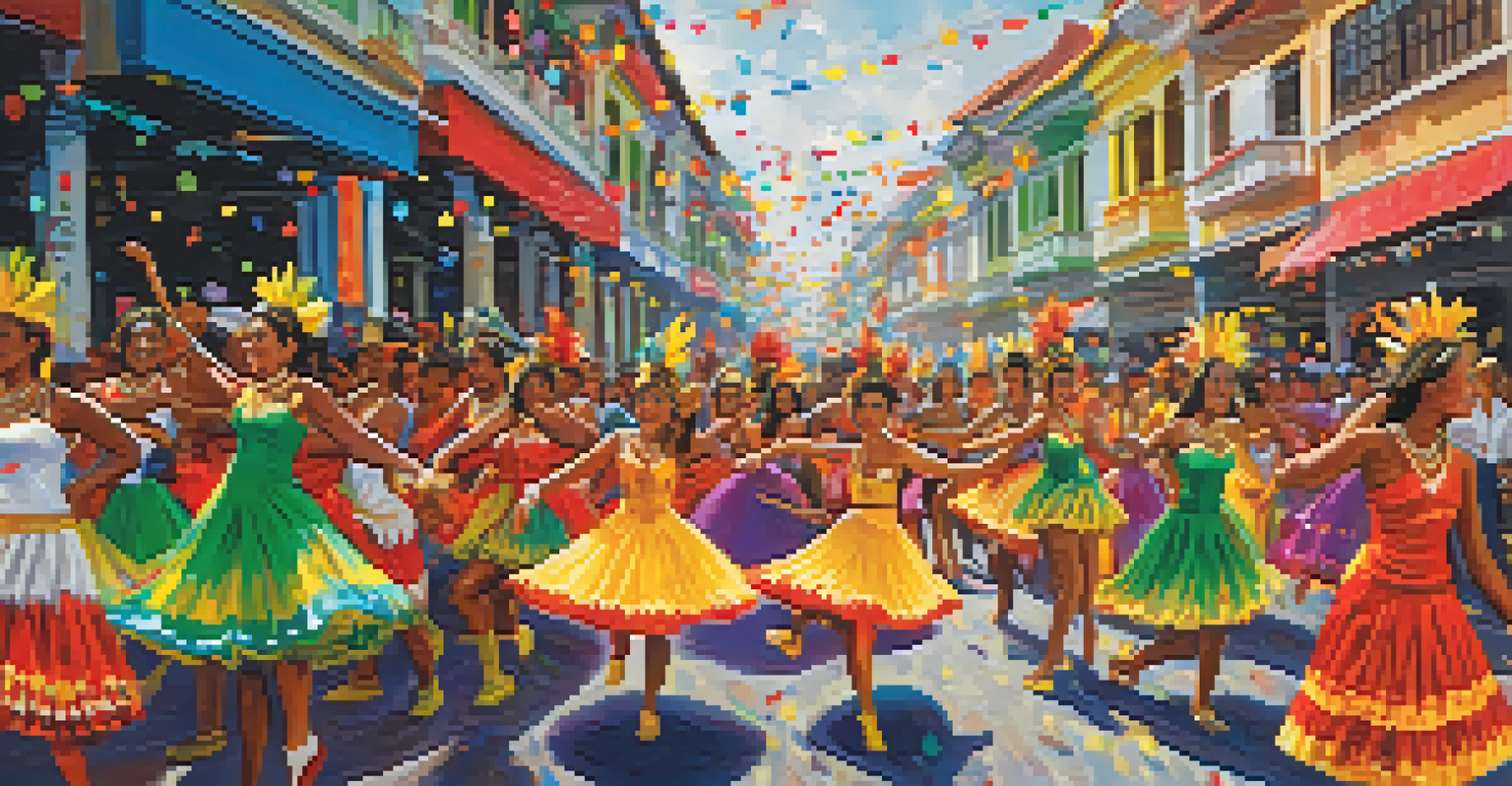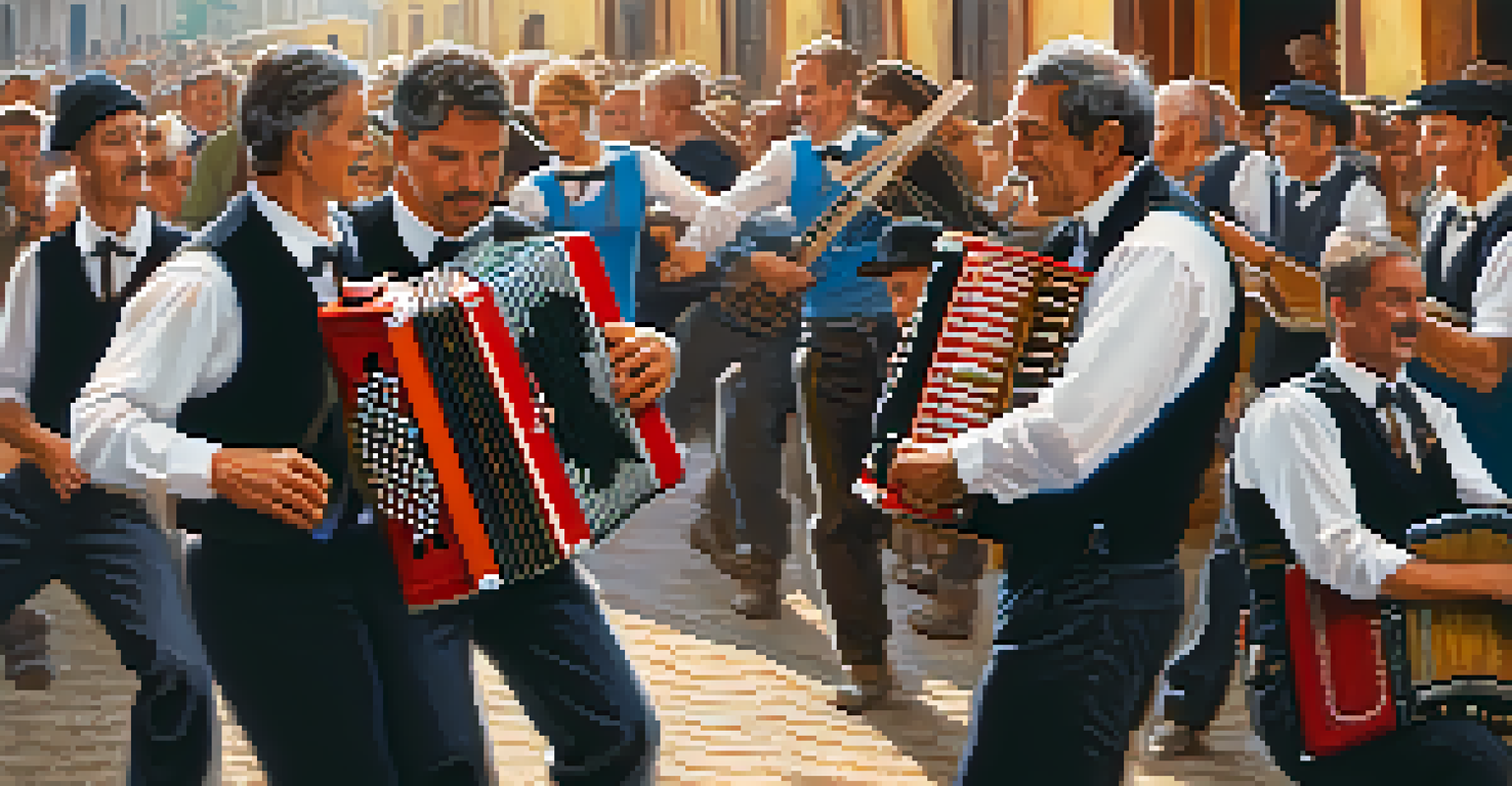The Role of Music in Northeast Brazil’s Festival Celebrations

The Heartbeat of Festivals: Music’s Central Role
In Northeast Brazil, music is more than just entertainment; it's the heartbeat of festival celebrations. From the rhythmic beats of forró to the festive sounds of axé, music sets the tone and energy of these vibrant events. Each festival, whether it's São João or Carnaval, is infused with melodies that evoke joy and community spirit.
Music can change the world because it can change people.
Music acts as a unifying force, bringing people together in celebration and shared experience. It's common to see families and friends dancing together, their movements synchronized with the pulsating rhythms that surround them. This communal aspect of music creates lasting memories and strengthens social bonds.
Moreover, the diversity of musical styles reflects the rich cultural tapestry of the region. Each genre carries its history and significance, inviting festival-goers to engage with the local heritage. This connection between music and identity plays a pivotal role in enhancing the overall festival experience.
Traditional Genres: Forró and Axé in Action
Forró, a popular genre originating from the Northeast, is synonymous with traditional festivities. Characterized by its lively accordion melodies and infectious dance, forró invites everyone to join in, regardless of age or skill level. The simplicity and joy of this music make it a staple at festivals, where people often gather to dance the night away.

On the other hand, axé music, which blends Afro-Brazilian rhythms with pop influences, brings its own unique flair to celebrations. It encourages a sense of festivity and exuberance, often featuring vibrant parades and colorful costumes. Axé has become a symbol of celebration, especially during Carnaval, where its infectious beats resonate through the streets.
Music Unites Festival Celebrations
In Northeast Brazil, music serves as a unifying force, bringing people together to celebrate and create lasting memories.
Both genres not only entertain but also convey stories of love, struggle, and celebration, reflecting the lives of the people. As festival-goers immerse themselves in these musical experiences, they engage with the heart and soul of Northeast Brazil's culture.
The Influence of Dance: Moving to the Music
Dance is an integral part of the musical experience during festivals in Northeast Brazil. Each rhythm invites specific dance styles, from the quick steps of forró to the lively movements of samba de roda. This dynamic interplay between music and dance creates an atmosphere of joy and expression.
Where words fail, music speaks.
At festivals, you'll find people of all ages participating in dance, showcasing their unique styles and interpretations. This communal dance experience fosters a sense of belonging, allowing individuals to express themselves while connecting with others. It's a beautiful sight to see a grandmother teaching her grandchild the steps of a traditional dance, passing down cultural heritage through movement.
Moreover, dance serves as a physical manifestation of the emotions evoked by music. When the melodies play, inhibitions fade, and the spirit of celebration takes over. This synergy between music and dance is what makes festivals in Northeast Brazil truly unforgettable.
Cultural Identity: Music as a Reflection
The music played during festivals in Northeast Brazil is a reflection of the region's cultural identity. It showcases the rich history, traditions, and influences that have shaped the local community over centuries. From Indigenous rhythms to African beats and European melodies, this blend of influences creates a unique soundscape that resonates deeply with the people.
As festival-goers immerse themselves in the music, they are reminded of their roots and shared heritage. This connection to cultural identity fosters pride and a sense of belonging, enhancing the overall festival experience. Music becomes a vehicle for storytelling, allowing generations to pass down their history and values.
Cultural Identity Through Music
The diverse musical genres reflect the rich cultural heritage of the region, enhancing the festival experience and fostering pride.
Additionally, the celebration of local music during festivals serves to preserve these cultural expressions in the face of globalization. As modern influences seep into the region, festivals provide a space for artists to showcase traditional sounds, ensuring that they continue to thrive in contemporary society.
Festivals as a Platform for Local Artists
Festivals in Northeast Brazil serve as a vital platform for local artists to showcase their talent. These events provide musicians with an opportunity to reach wider audiences, often leading to career advancements and recognition. The vibrant atmosphere of festivals encourages creativity and innovation, allowing artists to experiment with their music.
Moreover, the communal support during these gatherings fosters a sense of camaraderie among musicians. Local artists often collaborate, blending styles and influences to create unique performances that resonate with festival-goers. This collaborative spirit not only enhances the music but also strengthens the local artistic community.
By spotlighting local talent, festivals contribute to the preservation of cultural traditions while promoting new artistic expressions. This dynamic environment enables artists to thrive and ensures that the music scene in Northeast Brazil remains vibrant and diverse.
The Impact of Music on Festival Atmosphere
The atmosphere of a festival is undeniably shaped by its music. From the moment you step into the celebration, the sounds envelop you, setting the stage for an unforgettable experience. Music creates a sense of excitement and anticipation, drawing people in and encouraging them to participate in the festivities.
As the day transitions into night, the energy shifts, and the music evolves, keeping the momentum alive. Upbeat tunes invite dancing, while slower melodies provide moments of reflection and connection. This ebb and flow of music mirrors the diverse emotions experienced during festivals, creating a dynamic and engaging environment.
Festivals Boost Local Artists
These vibrant events provide local musicians a platform to showcase their talent, fostering creativity and collaboration within the community.
Ultimately, the music serves as a catalyst for joy, laughter, and connection. It enhances the sensory experience of the festival, making it a memorable occasion for all who attend. In this way, music is not just an accompaniment; it is the essence of celebration itself.
Conclusion: Music, Community, and Celebration
In conclusion, music plays a pivotal role in shaping the festival celebrations of Northeast Brazil. It brings people together, fosters cultural pride, and enhances the overall atmosphere of joy and connection. Whether through traditional forró or lively axé, the melodies echo the spirit of the community and the richness of its heritage.
Festivals are not just events; they are a celebration of life, culture, and shared experiences, with music serving as the vital thread that weaves them together. As people gather to sing, dance, and celebrate, they create a tapestry of memories that transcends generations.

The enduring power of music in these celebrations reminds us of the importance of community and the joy of coming together. In Northeast Brazil, music is not merely a soundtrack; it is the essence of life and celebration.